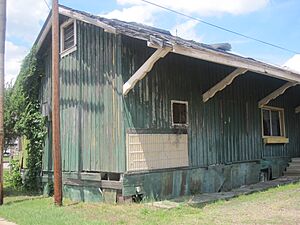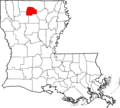Lincoln Parish, Louisiana facts for kids
Quick facts for kids
Lincoln Parish, Louisiana
|
||
|---|---|---|

Lincoln Parish Courthouse in Ruston
|
||
|
||

Location within the U.S. state of Louisiana
|
||

Louisiana's location within the U.S.
|
||
| Country | ||
| State | ||
| Region | North Louisiana | |
| Founded | 1873 | |
| Named for | Abraham Lincoln | |
| Parish seat (and largest city) | Ruston | |
| Area | ||
| • Total | 1,220 km2 (472 sq mi) | |
| • Land | 1,220 km2 (472 sq mi) | |
| • Water | 2 km2 (0.7 sq mi) | |
| • percentage | 0.5 km2 (0.2 sq mi) | |
| Population
(2020)
|
||
| • Total | 48,396 | |
| • Rank | LA: 25th | |
| • Density | 39.59/km2 (102.53/sq mi) | |
| Time zone | UTC-6 (CST) | |
| • Summer (DST) | UTC-5 (CDT) | |
| Area code | 318 | |
| Congressional district | 5th | |
| Website | Parish of Lincoln | |
Lincoln Parish is a special kind of county called a parish in the U.S. state of Louisiana. It's located in the northern part of the state. In 2020, about 48,396 people lived here.
The parish was created on February 24, 1873. It was formed from parts of other nearby parishes like Bienville, Claiborne, Union, and Jackson. This happened during a time called the Reconstruction Era, after the American Civil War.
At first, the main town, or parish seat, was Vienna. But in 1884, people voted to move the parish seat to a new railroad town called Ruston. Today, Ruston is the biggest city in Lincoln Parish.
Contents
History of Lincoln Parish
Ancient Times and Earthwork Mounds
Long, long ago, thousands of years before anyone built towns, ancient people lived in northern Louisiana. These indigenous cultures were hunter-gatherers, meaning they found their food by hunting animals and gathering plants.
Even without farms, they built amazing structures. They created huge earthwork mounds, which are like big hills made of dirt. These mounds were built over hundreds of years by many generations.
One of these ancient sites, called Hedgepeth Site, is in Lincoln Parish. It dates back about 5,200 to 4,500 years ago. These discoveries help us understand how early human cultures lived and built things.
How Lincoln Parish Was Formed
Lincoln Parish was one of several new parishes created in Louisiana during the Reconstruction Era. This was a time when the state government was trying to change how political power was set up.
In 1873, parts of four other parishes were combined to form Lincoln Parish. This was also done to take advantage of the new railroad lines that were being built. The parish was named after the famous U.S. president, Abraham Lincoln.
Politics in Lincoln Parish
In elections, Lincoln Parish usually votes for the Republican Party. This shows how the political views of the area have developed over time.
Geography
Lincoln Parish covers a total area of about 472 square miles (1,222 square kilometers). Most of this area is land, with only a very small part (about 0.7 square miles or 1.8 square kilometers) being water.
Main Roads
These are the major highways that run through Lincoln Parish:
 Interstate 20
Interstate 20 U.S. Highway 63
U.S. Highway 63 U.S. Highway 80
U.S. Highway 80 U.S. Highway 167
U.S. Highway 167 Louisiana Highway 33
Louisiana Highway 33 Louisiana Highway 146
Louisiana Highway 146
Neighboring Parishes
Lincoln Parish shares its borders with these other parishes:
- Union Parish (to the north)
- Ouachita Parish (to the east)
- Jackson Parish (to the south)
- Bienville Parish (to the southwest)
- Claiborne Parish (to the northwest)
Communities
Lincoln Parish has several towns and cities where people live.
Cities
Towns
Villages
Other Communities
These are smaller areas that are not officially cities, towns, or villages:
- Corinth
- Mount Zion
- Pleasant Hill
- Hico
- Hilly
- Unionville
Population Over Time
| Historical population | |||
|---|---|---|---|
| Census | Pop. | %± | |
| 1880 | 11,075 | — | |
| 1890 | 14,753 | 33.2% | |
| 1900 | 15,898 | 7.8% | |
| 1910 | 18,485 | 16.3% | |
| 1920 | 16,962 | −8.2% | |
| 1930 | 22,822 | 34.5% | |
| 1940 | 24,790 | 8.6% | |
| 1950 | 25,782 | 4.0% | |
| 1960 | 28,535 | 10.7% | |
| 1970 | 33,800 | 18.5% | |
| 1980 | 39,763 | 17.6% | |
| 1990 | 41,745 | 5.0% | |
| 2000 | 42,509 | 1.8% | |
| 2010 | 46,735 | 9.9% | |
| 2020 | 48,396 | 3.6% | |
| U.S. Decennial Census 1790-1960 1900-1990 1990-2000 2010 |
|||
The population of Lincoln Parish has grown quite a bit over the years. In 1880, there were just over 11,000 people. By 2020, the population had grown to more than 48,000 people. This shows how the parish has developed and attracted more residents over time.
Education
Education is very important in Lincoln Parish. Students here attend schools managed by the Lincoln Parish School Board.
The parish is home to two universities:
- Louisiana Tech University in Ruston
- Grambling State University in Grambling
There are also several schools for younger students:
- Bethel Christian School in Ruston
- Ruston High School in Ruston
- Lincoln Preparatory School in Grambling
- Choudrant Elementary School and Choudrant High School in Choudrant
- Cedar Creek (a school for K-12 grades) in Ruston
National Guard
The 527th Engineer Battalion, also known as "Triple Alpha," has its main office in Ruston, Louisiana. This group is part of the 225th Engineer Brigade of the Louisiana National Guard, which helps with engineering projects and supports the community.
Attractions and Fun Things to Do
Lincoln Parish offers many interesting places to visit and events to enjoy:
- Eddie G. Robinson Museum
- Lincoln Parish Park
- Louisiana Military Museum
- Lincoln Parish Museum
- Dixie Center for the Arts
- North Central Louisiana Arts Council
- Ruston Community Theatre
- Celebrity Theatre (a movie theater)
- The Annual Peach Festival held in Ruston
- The Annual Chicken Festival held in Dubach
- Kingdom Collectives Film Festival held in Ruston
Images for kids
See also
 In Spanish: Parroquia de Lincoln para niños
In Spanish: Parroquia de Lincoln para niños







